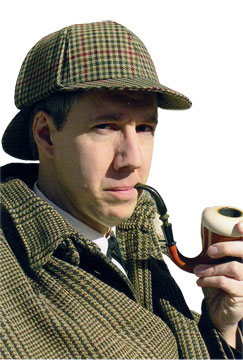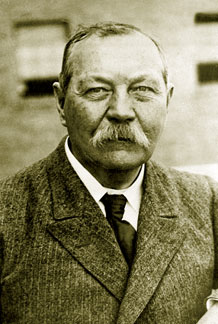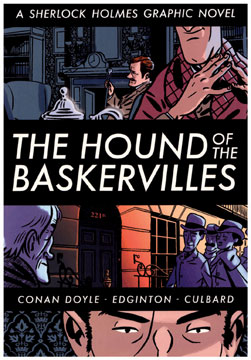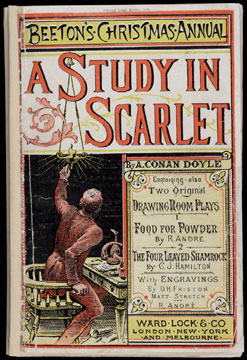Doyle's Sherlock or sheer luck
By Shireen Senadhira
Out of Colombo, staying in an old homestead, I awoke before dawn and
went out to the verandah. The colour was deep grey before discerning
shapes of the surroundings appeared at dawn. There was a chill in the
air though the wind had died down. As I was imbibing all this, there
came a baying of a hound. I felt a thrill and a chill! Were the
Baskerville hounds afoot? Aha! Before I could engage in further
thoughts, a second baying followed and that stopped me in mid step.
However, I regained my room. The baying, was it from a neighbourhood
large dog?
 |
|
Sherlock Holms |
A Great Dane, perhaps? ‘I must find out in the morning,’ I said to
myself. With such thoughts swirling around in my head, I looked at the
lawn through the window in the gloom. I saw the moors of Devon in
Dartmoor. It spread its length in the eerie light with rocks and mounds
on one side and swampy bogs here and there.
Did Arthur Conan Doyle hear a similar baying like this and connected
it with Devon’s folklore which included tales he had heard of a fearsome
supernatural dog known as the Yeth hound. The Baskerville Hall in the
story, is said to have been inspired by a visit to Cromer Hall in
Norfolk in England. Also, some other elements of the story had been
garnered by Doyle’s stay in Royal Union Hotel in West Renton, where he
heard of a ghost dog in the Cromer area which was said to have run
between Overstrand, a place in the east and East Renton, in the west.
Was this how Doyle combined all this with part of the history of the
Baskervilles of Devon and spun an intriguing tale, The Hound of the
Baskervilles? A story that has come down the ages and never lost its
fearsome mystery that is so well portrayed in the detective tale.
Searching for more details of this fascinating setting, I found out
that Doyle’s inspiration for the Baskerville tale of a hellish hound and
cursed country squire was drawn from the legend of Richard Cabell.
Incidentally, Cabell’s tomb can be seen in the Devon town of
Buckfastleigh.
Squire Richard Cabell was a local country squire of Buckfastleigh and
lived in the 17th century. He was a passionate hunter and was then
described as a ‘monstrously evil man.’ Among other things, he gained a
reputation for immorality and having sold his soul to the Devil! It was
also rumoured that he had murdered his wife. He was laid to rest in the
sepulcher when he died, but what happened then? The night of his
interment brought forth a pack of hounds baying across the moors to howl
at his tomb.
Then onwards, he could be found leading the pack across the moors
usually on the anniversary of his death. If the pack of hounds were not
out hunting, they could be found howling and shrieking around his tomb.
This was intolerable for the people of the area and they tried to rest
the soul of the deceased by building a large structure around the tomb
and to be doubly sure, a huge slab was placed on the top of the grave to
stop the ghost of the squire escaping.
What a beginning for a story and then to weave a tale of intrigue
with many different characters.
The main character is Sherlock Holmes, the detective and his
assistant is Dr Watson. There is a housekeeper and her butler husband.
Sir Charles Baskerville, the owner of Baskerville Hall, had died in fear
in the hall’s grounds.
Furthermore, there were large paw prints on the soil near his corpse.
There is the heir to Sir Charles, Sir Henry Baskerville, recently
arrived at the Hall from Canada. Dr Mortimer, a medical practitioner and
friend of the Baskervilles with rather eccentric habits who was made the
executor of Sir Charles’s estate. It was Dr Mortimer who informed
Sherlock Holmes and Dr Watson of the strange events surrounding Sir
Charles’s death. Also, a former school master, Mr Stapleton and his
sister Miss Stapleton, a Latin looking dusky beauty . In addition, a few
other characters, including an attractive lady who was disinherited by
her rich cranky father and to top it all an escaped convict too. Thus
the story was written in the late 19th century and continues to
fascinate, chill and thrill the hearts of mystery readers even at
present times. The story has been adapted in many film versions and very
commendable as it is still able to hold the viewer spellbound from
beginning to end. There is news to say that yet another version will be
aired as a BBC mini-series in the autumn of 2011.
 |
|
Sir Arthur Conan Doyle |
Actually, Doyle’s detective novels are Sherlock all the way and not
merely sheer luck. The many puzzling cases are deduced, reasoned and
solved. It is believed that Doyle, partially modelled Sherlock Holmes
after his former university teacher, Joseph Bell . It was Bell who
inculcated in his student, the power of deduction, after careful
inference and observation. There were many writers that inspired Doyle
and Robert Louis Stevenson was one of them. Stevenson, then living in
faraway Samoa was able to recognize the strong similarity between Joseph
Bell and Sherlock Holmes. Stevenson wrote to Doyle “My compliments on
your very ingenious and very interesting adventures of Sherlock Holmes.
Can this be my old friend, Joe Bell?”
First detective story
A Study in Scarlet was Doyle’s first detective story to be published.
It featured Sherlock Holmes who later became one of the most famous
literary detective characters with long lasting appeal. This story of
Conan is well known, probably, as it is the world’s introduction to the
illustrious Sherlock Holmes where his friendship was cemented with Dr
Watson, after meeting each other for the first time. It was also their
first mystery together. It is a longer and more detailed story than his
later stories.
It was Dr Watson’s old pal, Stamford, who introduced the famous duo
to each other. Therefore, it is surprising that Stamford after being so
specifically written about in the first pages of this book, is not
alluded to in any other detective story. Another point of interest is
that, A Study in Scarlet was the first work of fiction to use the
magnifying glass as a sleuthing tool. The title of the book was derived
from a statement made by Holmes to Watson, when he described the nature
of his work, the murder investigation of the story as a ‘study in
scarlet;’ followed by, ’there’s a scarlet thread of murder running
through the colourless skein of life, and our duty is to unravel it,
isolate it and expose every inch of it.’
This book was first published in 1887 in Beeton’s Christmas Annual.
Though the story and its main character attracted little public interest
at that time, it was a forerunner to the modern detective stories. It
must be noted, however, that there are only 11 copies of Beeton’s
Christmas Annual still around and they are of immense value.
A study in Scarlet is divided in two parts, the first part is the
story up to the arrest of the murderer, and the second part furnishes
details of the background of the story. Part two takes the reader across
the ocean to the original settlement of Salt Lake City in Utah in North
America and a story of hardship, love, greed, Mormons and revenge and
then back to London for the conclusion. The two parts are of the same
size and as you read it, you think of whether such explanations are
necessary , with Mormons on the American landscape and such till you get
the gist of it and then you realize Mormons can add a lot of colour and
excitement too.
The style of writing in this book is very proper as it was written in
the late 19th century. Doyle’s description of the less known lands of
America is majestic and breathtaking in comparison to London’s dirty
streets full of vice and crime.
The first part of the story is narrated by Dr Watson and the second
part is written in the third person. One of the drawbacks is, that a
reader solver of the mystery does not have enough clues to solve the
crime by himself in the first part of the story and the first part ends
in arresting the culprit. The writing in this book is captivating and
Doyle brilliantly sums up the personalities of Sherlock Holmes and Dr
Watson. In fact, in a very short time, readers feel as if they know
these two men.
Plots and themes
In, The Hound of Baskervilles, the story is followed in Watson’s
perspective. The time span is brief as it is only a matter of a few
weeks for the story to unfold. The usual climatic conditions of England
is seen mostly in the last two days only. The old warning legend is told
by Dr Mortimer and also gathered from Dr Watson’s diary entries of
recorded conversations. All this and the descriptive setting contribute
to the plot bringing in the correct atmosphere making the legend
believable. It is usual that the plot follows the collection of clues
and results. There are three possible leads in the story and that is a
puzzle for the readers to untangle.
|
 |
|
The Hound of the
Baskervilles |
|
 |
|
A Study in Scarlet |
Evil and supernatural themes are exposed in this story. Though the
two doctors, Mortimer and Watson scoff at the hound as just a curse and
a myth, nothing can be done to stop it, as the area is well steeped in
legend. The ambience of supernatural is everywhere, about the moors,
from the fog and the swamp land to the Neolithic caves and gothic like
mansions on the environs of the moors. There is a criminal too hiding in
the moors. The reader is left without the details of his crime and
therefore cannot sympathize with the victim.
There is also the pursuit of money and power, a human trait that is
seen to the present day. Stapleton’s large collection of pinned
butterflies in glass cases show cruelty to animals. Butterflies could be
caught, observed for research purposes and set free. Many lies too are
uttered in the story and these are a cover up to the situation.
In A Study of Scarlet, there is the eternal issue of love between man
and woman and jealousy. Greed and revenge too are displayed as the story
goes on and it is enhanced by the bloody word, Rache, written on the
wall. The word was not short for Rachel but revenge in German. The novel
introduces, the famous twosome, to the reader successfully. It also
shows how Sherlock is a consultant to Scotland yard.
An abrupt flash back in the middle of the novel is striking. Just as
we eagerly await the solving of the case, we are thrown back to a
completely different story. It could be debated that most readers would
find a summary of the flash back story sufficient. Nevertheless, the
flashback though lengthy, is written well as Doyle’s other writings and
is less disruptive when you are aware of it. The setting of this novel
is in two countries, one, in the late 19thcentury London and the other,
the State of Utah in North America. The Mormons in the story add a
special angle to the story.
Arthur Conan Doyle, a Scotsman, was born in Edinburgh and later
studied medicine there too. At Edinburgh University he met his mentor,
professor and Doctor Joseph Bell. Inspired by Sir Walter Scott, Robert
Louis Stevenson, Edgar Allen Poe and Guy de Maupassant, Doyle’s now
iconic mastermind sleuth and his companion, Dr Watson, brought forth a
new detective genre. Doyle’s medical training under Dr Bell and his
practical experience as a doctor were the foundation for Holmes’s
methods of deduction in solving the mysteries.
Eventually, Doyle served as a physician in the Boer War (1899-1902).
By the 1920s he was deeply interested in Spiritualism. At that time,
others including, Elizabeth Barrett Browning believed that the living
could communicate with the dead. After writing, A study in Scarlet, he
followed it with 56 more short stories, 4 novels featuring Sherlock
Holmes and Dr Watson. He also wrote many other fiction and non-fiction.
While Doyle was serving as an eye specialist having consulting rooms
at Devonshire Place, near Harley Street in 1891, we must be thankful to
the citizens with eye trouble who did not visit Doyle’s offices. Why? It
is because, it was there, waiting for the patients who never came, that
Doyle began to form and write the stories of Sherlock Holmes.
Thus, the Sherlock Holmes Saga has given the mystery lovers to read,
over and over again the stories, as well as the world, much pleasure.
Also, it has brought the familiar scenes of Holmes’s sitting rooms in
Baker Street, London, to us. We can easily visualize Holmes stretched
out on the sofa in a fit of dumps: perhaps he is scraping on the violin,
bemoaning the dearth of imaginative crime.
These rooms we know so well. There are the great volumes of scrap
book records, which sometimes Holmes pulls out and throws them all over
the floor. Bullet marks are on the wall, the siphon bottles, the Persian
slipper for tobacco and tea laid out on the table. In comes, Mrs Hudson
with a message and all are once again, ‘off.’ A hansom is heard rattling
through the streets of Waterloo, Paddington and Charring Cross.
|

